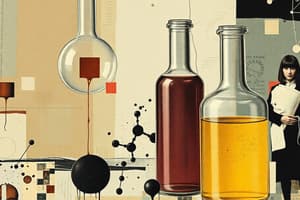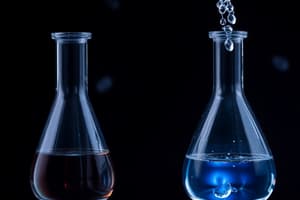Podcast
Questions and Answers
Which of the following describes a compound?
Which of the following describes a compound?
- A sample containing only one type of atom
- A pure substance that cannot be broken down
- A substance formed from chemically combining elements (correct)
- A mixture of two or more substances
What distinguishes a solid from a liquid?
What distinguishes a solid from a liquid?
- Solids have both a definite shape and volume (correct)
- Solids are composed only of molecules
- Solids can flow and take the shape of the container
- Solids have a definite volume but not a definite shape
How is the atomic number of an element defined?
How is the atomic number of an element defined?
- The total number of neutrons in an atom
- The number of electrons surrounding the nucleus
- The sum of protons and electrons
- The number of protons in the nucleus of an atom (correct)
Which property best describes how a substance reacts with other substances?
Which property best describes how a substance reacts with other substances?
In the periodic table, how are elements primarily organized?
In the periodic table, how are elements primarily organized?
Flashcards
What is matter?
What is matter?
Anything that occupies space and has mass. It can be a pure substance (like an element) or a mixture of substances.
What are elements?
What are elements?
Pure substances that cannot be broken down into simpler substances by chemical means. Examples: hydrogen, oxygen, carbon.
What are compounds?
What are compounds?
Substances formed when two or more elements combine chemically in a fixed ratio. Example: water (H2O) formed from two hydrogen atoms and one oxygen atom.
What are physical properties?
What are physical properties?
Signup and view all the flashcards
What are chemical properties?
What are chemical properties?
Signup and view all the flashcards
Study Notes
Matter and its Properties
- Matter is anything that occupies space and has mass.
- Elements are pure substances that cannot be broken down into simpler substances by chemical means. Examples include Hydrogen (H), Oxygen (O), and Carbon (C).
- Compounds are substances formed when two or more elements combine chemically in a fixed ratio. Water (H₂O) is an example, formed from two hydrogen atoms and one oxygen atom.
- Mixtures are combinations of two or more substances that are not chemically combined and can be separated by physical methods. Saltwater is a mixture.
- Physical properties are characteristics that can be observed or measured without changing the substance's chemical composition. Examples include color, density, melting point, and boiling point.
- Chemical properties describe how a substance reacts with other substances and undergoes a chemical change. Flammability is an example, describing how easily a substance burns.
States of Matter
- Matter exists in three fundamental states: solid, liquid, and gas.
- Solids have a definite shape and volume. Particles are closely packed and vibrate in fixed positions.
- Liquids have a definite volume but take the shape of their container. Particles are close together but can move past each other.
- Gases have neither a definite shape nor a definite volume. Particles are widely spread and move freely in all directions.
Atomic Structure
- Atoms are the basic building blocks of matter.
- Atoms are composed of a positively charged nucleus containing protons and neutrons, surrounded by negatively charged electrons.
- Protons carry a positive charge (+1), neutrons are neutral, and electrons carry a negative charge (-1).
- The number of protons in an atom's nucleus determines the element it is.
- The atomic number is the number of protons.
- The mass number is the sum of protons and neutrons.
Periodic Table
- The periodic table is a tabular arrangement of elements.
- Elements with similar properties are grouped together in columns called groups or families.
- Rows are called periods, reflecting patterns in the atomic structure of the elements.
- Elements are arranged from left to right in order of increasing atomic number.
- Metals typically are good conductors of heat and electricity.
- Nonmetals tend to be poor conductors of heat and electricity.
Chemical Reactions
- Chemical reactions are processes that involve the rearrangement of atoms to form new substances.
- Reactants are the substances that undergo a change.
- Products are the new substances formed.
- Chemical equations represent chemical reactions symbolically. For example, 2H₂ + O₂ → 2H₂O shows two molecules of hydrogen react with one molecule of oxygen to produce two molecules of water.
- Different types of chemical reactions include combustion, decomposition, displacement, and neutralization reactions.
Acids, Bases, and Salts
- Acids are substances that release hydrogen ions (H⁺) when dissolved in water. They often taste sour.
- Bases are substances that release hydroxide ions (OH⁻) when dissolved in water. They often feel slippery and taste bitter.
- Salts are formed when an acid reacts with a base.
- The pH scale measures the acidity or basicity of a solution. An acidic solution has a pH less than 7, a basic solution has a pH greater than 7, and a neutral solution has a pH of 7.
Important Concepts
- Conservation of mass: The mass of reactants equals the mass of products in a chemical reaction.
- Separating mixtures: Techniques like filtration, evaporation, distillation, and chromatography are used to isolate components of a mixture.
Measurement and Calculations
- Significant figures in measurements reflect the degree of accuracy.
- Various units are used for expressing quantities in chemistry, like grams (g), liters (L), and moles (mol).
- Calculations in stoichiometry involve finding the mass, moles, or volumes of reactants and products using balanced chemical equations.
Laboratory Safety
- Always wear appropriate safety goggles and lab aprons.
- Handle chemicals and glassware with care.
- Understand the hazards of different chemicals.
- Know the location of safety equipment like fire extinguishers, eye washes, and first aid kits.
Studying That Suits You
Use AI to generate personalized quizzes and flashcards to suit your learning preferences.




